|

In January of 2001, a Dr.Volodymyr Krasnoholovets
from the Institute of Physics in the Ukraine contacted me. (The
Institute of Physics was considered the top military research
institute of the former Soviet Union.) This institute helped develop
the Russian cruise missiles, remote sensing devices, satellites,
space station technology, and other military technology. Dr. K (as
we now call him) identified himself as a senior scientist at that
Institute. He told me that in the last 10 years, he and his
colleagues were carrying out research in 17 large fiberglass
pyramids, built in 8 different locations in Russia and Ukraine.
These pyramids varied in size, the largest being 144 feet high and
weighing over 55 tons.
I had not been aware of these pyramids but it seemed that people
from Russia knew about them. I was told that they are popular
tourist attractions and many people visit them. Dr. K sent me photos
of these pyramids along with a comprehensive research article about
experiments conducted in them, which he and his colleagues wrote.
They asked me to post it on our web site and invited me to
collaborate with them in their pyramid research. Dr. K explained
that the Russians and Ukrainians conducted many kinds of experiments
using these pyramids that included such fields as medicine, ecology,
agriculture, chemistry and physics. What is significant about this
research is that it scientifically documents the changes in both
biological and non-biological materials that occur as a result of
being placed in these pyramids. So I posted their research article
on our web site and subsequently appeared on several major radio
programs.
Then in February of 2001, the individual who actually financed and
built the pyramids in Russia and the Ukraine contacted me directly.
He was Alexander Golod, a scientist and now Director of a State
Defense Enterprise in Moscow. He found my web site and saw that I
was releasing the research carried out in his pyramids. Alexander
does not speak English so most of our communications were carried
out through his son, Anatoli. He told me that his father, Alexander,
started constructing these pyramids in 1989. The Golod’s wanted to
work with me also and to help publicize and continue their research.
In two month’s time, I was working with both the builders and some
of the major researchers of these pyramids.
Alexander had decided to build these pyramids because he believed
that they would produce an energy field that could affect biological
and non-biological objects. He even got support from the Russian
government for this massive building project and convinced them in
1998 to take a kilo of rocks that had been placed in one of his
pyramids on board the MIR space station. He felt the energy fields
they produced would help the space station and possibly the entire
world. Let us look at these pyramids.
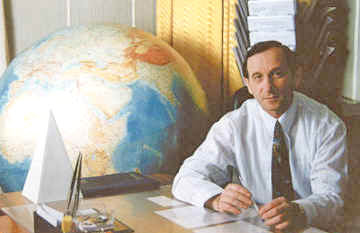
Alexander Golod in his office in Moscow
The largest and most recently built of the pyramids is located about
200 miles northwest of Moscow on Novorizhskoe Highway. It is 144
feet high and was completed in 1999. It weighs about 55 tons and
cost over 1 million dollars to build. It is made of fiberglass.
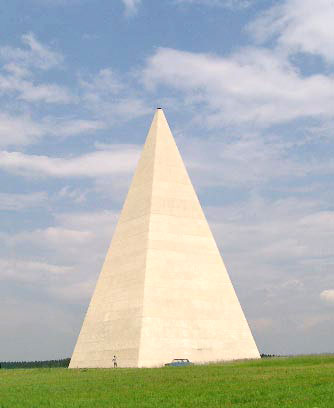
144 foot Pyramid
The below image is an aerial view of the 144-foot pyramid. This photo was taken
from a glider and you can see its countryside location. Notice that
it has a sharper slope (greater acute angle) than the Great Pyramid
of Giza. The Great Pyramid has a slope of about 52 degrees and these
pyramids rise at about a 73-degree angle. The reason Alexander Golod
chose this angle was based on experimental designs that also
included the mathematical relationship called the Golden Section. In
his prototype experiments, it was determined that no metal should be
included in the structure of these pyramids, so fiberglass was
chosen since it would be strong enough to also withstand the strong
winds that occur in and near Moscow. When Alexander Golod was asked
why he built these pyramids, he replied
“I have children, I have a
grandson, I do it for them. These pyramids are an instrument to make
the world a better place to live and benefit mankind”.
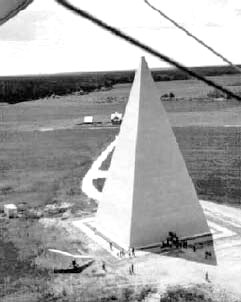
144 foot Pyramid
Everyone wants a photo in front of the pyramid. People from all over
Russia, including government officials, cosmonauts, and even famous
Russian actresses visit this largest pyramid and spend time inside
it. Millions of people have visited this pyramid and on crowded
days, you have to wait in line to enter it. Over the New Year’s
weekend, they counted 20,000 people in one day.
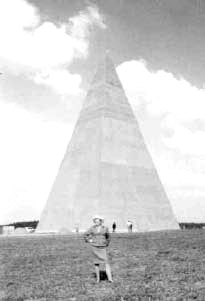
Russian Actress, Clara Luchko,
in front of the 144-foot pyramid
The next largest pyramid is the 72-foot pyramid, which is located 15
km from lake Seliger (Ostashkov area of Tver region, Russia). It was
completed in June of 1997. Notice that it is exactly one half the
size of the largest pyramid (144 ft). As mentioned, the design of
these pyramids was based on the Golden Section, used by ancient
architects to design many structures. This would dictate that the
pyramid sizes must be built in ratios.
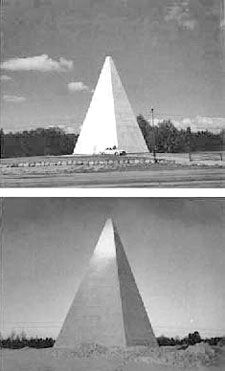
Several views of the 72-foot pyramid
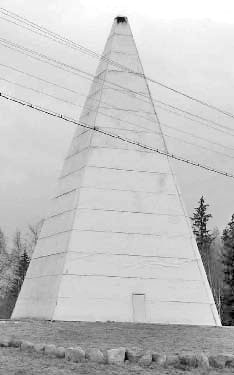
Shown below is the next (third) largest pyramid, which is 36 feet
high. Notice it is exactly one third the size of the largest
pyramid. It is located in Romenskoey, which is a suburb of Moscow.
This is one of the first pyramids built and where the first
experiments began.
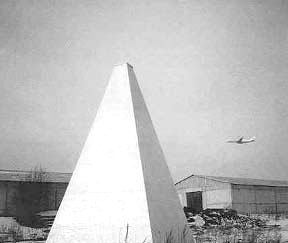
36 foot Pyramid
A design factor common to all the pyramids that Golod built is that
they must be hollow inside. This design element was determined in
experiments using prototype models before the building of the large
pyramids. Thus, two important conditions of construction were that
the pyramids must have no metal in them and they must be hollow.
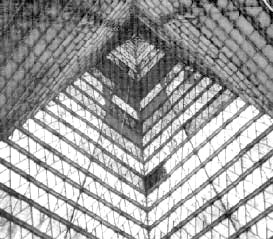
Inside the 144 foot pyramid gazing upwards
Below is a group of pyramids built in an oil field in Bashkiriya,
southern Russia to test the effect of a complex of pyramids on the
physical and chemical properties of oil. Their sizes are ratios of
the large pyramid.

Pyramid complex in oil field
Interest in pyramids in Russia is nothing new, as it even goes back
to the turn of the 19th century. This is a pyramid that was built in
the late 1800’s to be used as a wine cellar. It is called the EARL ORLOV WINE-CELLER PYRAMID. Supposedly, wine placed in this pyramid
tastes better. Even at that time people believed that the pyramid
shape could affect certain objects.
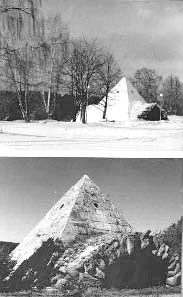
Earl Orlow Wine Cellar Pyramid
The upper photo shows people in front of the largest pyramid
celebrating its opening. The lower photos are the inside of the
pyramid on ground level. On a weekend with nice weather, as many as
5000 visitors show up.
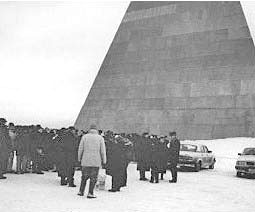
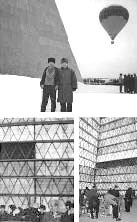
Opening day at the 144 foot pyramid
In October of 1998, crystals that were placed in one of the Russian
Pyramids were brought aboard the RUSSIAN MIR SPACE STATION and
remained on board for over a year. Crystals were also brought on the
INTERNATIONAL SPACE STATION for 10 days by cosmonaut Afanasiev.
Alexander Golod believed that these crystals would benefit both the
space stations and the world.

MIR Space Station
The next photo shows Alexander Golod with Cosmonaut
Georgiy Grechko
and G. Lozino-Lozinskiy during construction of the largest pyramid.
G, Lozino-Lozinskiy was the inventor of the Buran rocket, considered
the most powerful rocket in the world. Grorgiy Grechko was the
Soviets 4th cosmonaut. Future building plans include the
construction of a 288-foot pyramid (twice the size of the 144 foot
pyramid). They believe that the larger the pyramid, the great the
effect it produces.

Lozino-Lozinsky, Golod, and Grechko
Interesting photo of the 144-foot pyramid from a distance. This was
released from a Russian tourist office. Pictures of these pyramids
are included in their brochures. A guard stands vigil night and day
at this pyramid.
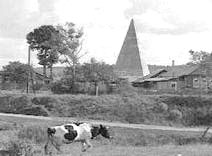
144-foot pyramid from a distance
Meet the guard, Sergey Shuvalov. You can phone him before the
journey to make arrangements for a tour. He lives near the pyramid
and knows just about everything about it.
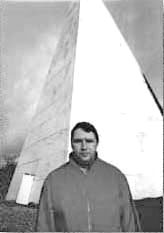
Sergey Shuvalov in front of the pyramid
You never know what to expect with these pyramids. Soon after the
construction of this pyramid near Moscow, botanists noticed extinct
flowers starting to grow near it. It is unknown why this has
happened and has mystified botanists.
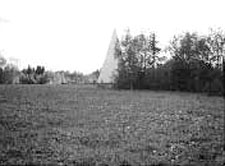
Extinct flowers growing in the vicinity of the pyramid
One of the most interesting observations regarding these pyramids
comes from Russian Air Force “Radar” (or “Locator” as they call it).
The first indication that the pyramids were producing strange
atmospheric effects was when the 144 foot or largest pyramid was in
the process of being built. The planned pyramid would be composed of
30 main layers or sections of fiberglass. At the completion of the
11th section, Air Force radar picked up an ion column coming right
off the pyramid. This ion column was very large and in fact was over
1 mile high.
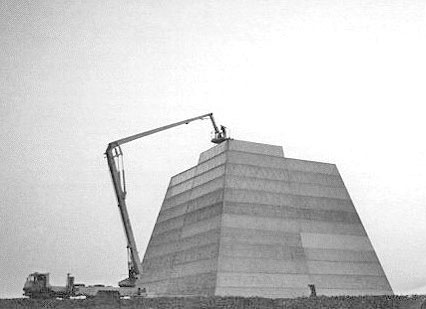
11 layers of the 30 completed of the 144-foot pyramid
As the pyramid construction continued, the
ion column still
remained. At the completion of the pyramid, a special weather
balloon was launched to measure this ion column. The results will be
discussed in the next chapter.
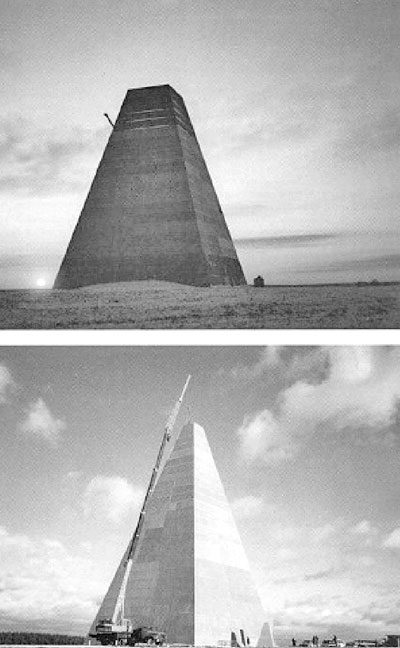
Construction phases of the 144-foot pyramid
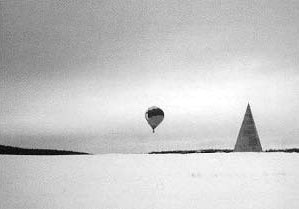
Weather Balloon used to measure ion column of pyramid
Alexander Golod had
a dream over 10 years ago of building large pyramids to make the
world a better place to live.

Alexander Golod
|





















